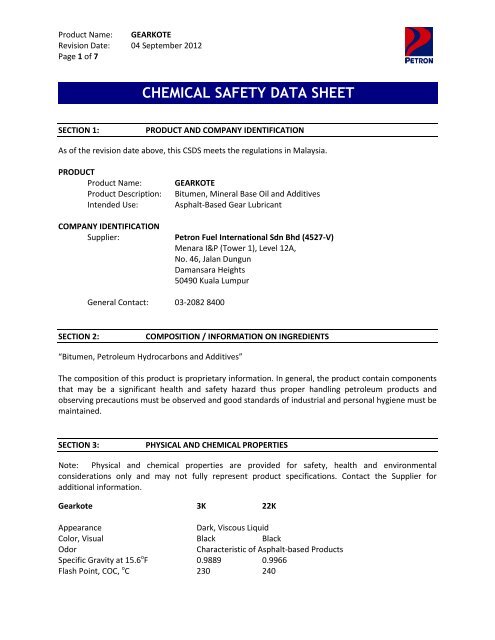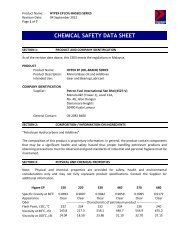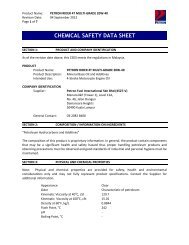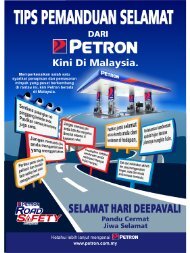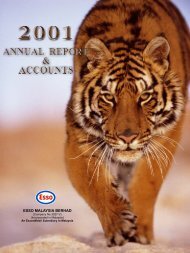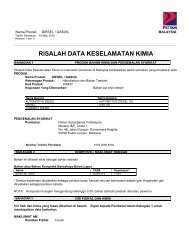(E) PDF here - Petron
(E) PDF here - Petron
(E) PDF here - Petron
You also want an ePaper? Increase the reach of your titles
YUMPU automatically turns print PDFs into web optimized ePapers that Google loves.
Product Name: GEARKOTERevision Date: 04 September 2012Page 1 of 7CHEMICAL SAFETY DATA SHEETSECTION 1:PRODUCT AND COMPANY IDENTIFICATIONAs of the revision date above, this CSDS meets the regulations in Malaysia.PRODUCTProduct Name:Product Description:Intended Use:COMPANY IDENTIFICATIONSupplier:GEARKOTEBitumen, Mineral Base Oil and AdditivesAsphalt-Based Gear Lubricant<strong>Petron</strong> Fuel International Sdn Bhd (4527-V)Menara I&P (Tower 1), Level 12A,No. 46, Jalan DungunDamansara Heights50490 Kuala LumpurGeneral Contact: 03-2082 8400SECTION 2:COMPOSITION / INFORMATION ON INGREDIENTS“Bitumen, Petroleum Hydrocarbons and Additives”The composition of this product is proprietary information. In general, the product contain componentsthat may be a significant health and safety hazard thus proper handling petroleum products andobserving precautions must be observed and good standards of industrial and personal hygiene must bemaintained.SECTION 3:PHYSICAL AND CHEMICAL PROPERTIESNote: Physical and chemical properties are provided for safety, health and environmentalconsiderations only and may not fully represent product specifications. Contact the Supplier foradditional information.Gearkote 3K 22KAppearanceDark, Viscous LiquidColor, Visual Black BlackOdorCharacteristic of Asphalt-based ProductsSpecific Gravity at 15.6 o F 0.9889 0.9966Flash Point, COC, o C 230 240
Product Name: GEARKOTERevision Date: 04 September 2012Page 2 of 7Viscosity at 40 o C, cSt 3,215 21,500Viscosity at 100 o C, cSt 73.93 226.0pH - -Boiling Point, °C - -Pour Point, °C - -Vapor Pressure, kPa - -Vapor Density - -Solubility in WaterNot soluble /ImmiscibleEvaporation Rate - -Partition CoefficientSECTION 4:HAZARDS IDENTIFICATIONThis material is not considered to be hazardous according to regulatory guidelines (see CSDS Section 15).HEALTH HAZARDSLow order of toxicity. Excessive exposure may result in eye, skin, or respiratoryirritation. High-pressure injection under skin may cause serious damage.NOTE: This material should not be used for any other purpose than the intended use in Section 1without expert advice. Health studies have shown that chemical exposure may cause potential humanhealth risks which may vary from person to person.SECTION 5:INHALATIONSKIN CONTACTEYE CONTACTINGESTIONFIRST AID MEASURESThis product has a low vapor pressure and is not expected to present aninhalation problem at ambient temperature. However, if overexposed to oilmist, using proper respiratory protection, immediately remove the affectedperson immediately to fresh air. Administer artificial respiration if breathing isstopped. Keep at rest. Call for prompt medical attention.Immediately flush with large amount of water; use soap if available. Removecontaminated clothing and shoes, and launder before reuse.Immediately flush eyes with large amount of water for at least 15 minutes oruntil irritation subsides. If irritation persists, get prompt medical attention.If swallowed, DO NOT induce vomiting. If individual is conscious, give milk orwater to dilute stomach contents. Keep warm and quiet. Get immediate medicalattention. DO NOT attempt to give anything by mouth to an unconsciousperson.SECTION 6:FIRE FIGHTING MEASURESEXTINGUISHING MEDIAIn case of fire use foam, carbon dioxide or dry chemical extinguishers.
Product Name: GEARKOTERevision Date: 04 September 2012Page 3 of 7FIRE FIGHTING PROCEDURESSpecial Fire-fighting Procedures: Water jets should not be used directly on igniting products. Avoidspraying water directly into storage containers due to danger of boil-over.However, water may be used to cool exposed containers, structures andequipment adjacent to fire. Respiratory and eye protection required for firefightingpersonnel.Hazardous Combustion Products: Fumes, smoke, oxides of sulfur, nitrogen, carbon and other toxicgases may be formed.FLAMMABILITY PROPERTIESFlash Point, °C (COC): Gearkote 3K (230); Gearkote 22K (240)Auto-ignition Temperature: N/DSECTION 7:ACCIDENTAL RELEASE MEASURESNOTIFICATION PROCEDURESIn the event of a spill or accidental release, notify relevant authorities in accordance with all applicableregulations.PROTECTIVE MEASURESAvoid contact with spilled material. See Section 6 for fire-fighting information. See the HazardIdentification Section for Significant Hazards. See Section 5 for First Aid Advice. See Section 8 for adviceon the minimum requirements for personal protective equipment. Additional protective measures maybe necessary, depending on the specific circumstances and/or the expert judgment of the emergencyresponders. For emergency responders: Respiratory protection: respiratory protection will benecessary only in special cases, e.g., formation of mists. Half-face or full-face respirator with filter(s) fordust/organic vapor or Self Contained Breathing Apparatus (SCBA) can be used depending on the size ofspill and potential level of exposure. If the exposure cannot be completely characterized or an oxygendeficient atmosp<strong>here</strong> is possible or anticipated, SCBA is recommended. Work gloves that are resistantto hydrocarbons are recommended. Gloves made of polyvinyl acetate (PVA) are not water-resistant andare not suitable for emergency use. Chemical goggles are recommended if splashes or contact with eyesis possible. Small spills: normal antistatic work clothes are usually adequate. Large spills: full body suitof chemical resistant, antistatic material is recommended.SPILL MANAGEMENTLand Spill: Taking normal safety precaution, eliminate sources of ignition. Preventadditional discharge of material, if possible to do so without hazard. For smallspills, implement cleanup procedures. For large spills, implement clean-upprocedures and, if in public area, keep public away and advise authorities.Prevent liquid from entering sewers, water courses, or low areas. Contain
Product Name: GEARKOTERevision Date: 04 September 2012Page 4 of 7spilled liquid with sand or earth. Recover by pumping or with a suitableabsorbent. If liquid is too viscous for pumping, scrape up. Consult an expert ondisposal of recovered material and ensure conformity to local disposalregulations.Water Spill:SECTION 8:HandlingStorageSECTION 9:Use booms to confine spills immediately. Remove from water surface byskimming or with suitable adsorbents. If allowed by local authorities andenvironmental agencies, sinking and/or suitable dispersants may be used innon-confined waters. Consult an expert on disposal of recovered material andensure conformity to local disposal regulations.HANDLING AND STORAGEKeep away from potential sources of ignition. Open container in a wellventilatedarea. Avoid breathing vapors. Keep containers closed when not inuse. Wash thoroughly after handling. “Empty” containers with retained productresidue (liquid or vapor) can be dangerous. Do not pressurize, cut, weld, braze,solder, drill, grind or expose containers to heat, flame, sparks, static electricityor other sources of ignition; they may explode and cause death or injury. Emptydrums should be completely drained, properly bunged and promptly returnedto a drum re-conditioner, or properly disposed off.Do not store near potential sources of ignition. Store in well-ventilated area.Odorous and toxic fumes may form from the decomposition of this product ifstored at temperatures in excess of 60 o C for extended periods of time or if heatsources in excess of 70 o C are used.EXPOSURE CONTROLS/ PERSONAL PROTECTIONExposure limits/standards for materials that can be formed when handling this productComponents Source ValueBitumen ACGIH 200 ppm, TLVPetroleum Hydrocarbons and additives ACGIHOSHA5mg/m 310 mg/m 3 (STEL)5mg/m 3NOTE: Limits/standards shown for guidance only. Follow applicable regulations.ENGINEERING CONTROLSPERSONAL PROTECTIONThe level of protection and types of controls necessary will varydepending upon potential exposure conditions. No specialrequirements under ordinary conditions of use and with adequateventilation.Personal protective equipment selections vary based on potentialexposure conditions such as applications, handling practices,concentration and ventilation. Information on the selection of
Product Name: GEARKOTERevision Date: 04 September 2012Page 5 of 7protective equipment for use with this material, as provided below, isbased upon intended, normal usage.Respiratory Protection:Hand Protection:Eye Protection:Skin and Body Protection:ENVIRONMENTAL CONTROLSUse self-contained breathing apparatus for entry into confined space,for other poorly ventilated areas and for large spill clean-up sites. Theuse of local exhaust ventilation is recommended to control mists orvapors. Additional ventilation or exhaust may be required to maintainair concentrations below exposure limits.Use chemical resistant gloves.W<strong>here</strong> contact may occur, wear safety glasses with side shields.Wear either a chemical protective suit or apron when potential forcontact with material exists. Use neoprene or nitrile rubber boots whennecessary to avoid contaminating shoes. Do not wear rings, watches orsimilar apparel that could entrap the material and cause a skin reaction.Comply with applicable environmental regulations limiting discharge toair, water and soil. Protect the environment by applying appropriatecontrol measures to prevent or limit emissions.SECTION 10:Stability:Incompatibility:STABILITY AND REACTIVITYThis product is stable and hazardous polymerization will not occur. However,the product should not be heated above 70 o C to avoid possible release of highlytoxic hydrogen sulfide and odorous alkyl mercaptans.Strong oxidizing agentsHazardous Decomposition Products: Hydrogen Sulfide (toxic)Polymerization:Not ApplicableSECTION 11:TOXICOLOGICAL INFORMATIONRoute of ExposureIngestionBitumen: Oral, LD50: >5,000 mg/kgPetroleum Hydrocarbons: Oral, LD50: >5,000 mg/kgInhalationPetroleum HCs: Inhalation, LC50: 2.18 mg/LConclusion / RemarksIngestion is an unlikely event. However, if morethan several mouthfuls are swallowed, abdominaldiscomfort, nausea, and diarrhea may occur.Minimal toxicity
Product Name: GEARKOTERevision Date: 04 September 2012Page 6 of 7SkinBitumen: Dermal, LD50: >2,000 mg/kgPetroleum HCs: Dermal, LD50: >2,000 mg/kgEyeLow order of toxicity. Frequent or prolongedcontact may cause mild skin discomfort.Will cause eye discomfort; may injure eye tissue ifnot removed promptly.SECTION 12:ECOLOGICAL INFORMATIONThe information given is based on data available for the material, the components of the material, andsimilar materials.ECOTOXICITYMOBILITYNo dataOil component of this product floats and can migrate from water to land.PERSISTENCE AND DEGRADABILITYBiodegradation:Data have not been determined specifically for this product, but it is notexpected that it will be “readily” biodegradable.BIOACCUMULATION POTENTIALData have not been determined specifically for this product, but it is expected tobe harmful to aquatic organisms.SECTION 13:DISPOSAL INFORMATIONMaterial, if discarded, is expected to be hazardous waste due to toxicity. Waste management should bein compliance with local and national regulations.SECTION 14:LANDSEAAIRTRANSPORT INFORMATIONThis product is not regulated for road/rail transport.IMDG (Packaged Goods and BLCs). This product is not regulated for sea transport.(ICAO/IATA). This product is not regulated for air transport.SECTION 15:REGULATORY INFORMATIONMaterial is not hazardous as defined by the Occupational Safety and Health (Classification, Packaging,and Labeling of Hazardous Chemicals) Regulations.CLASSIFICATIONNot regulated
Product Name: GEARKOTERevision Date: 04 September 2012Page 7 of 7LABELINGNot regulatedREGULATORY STATUS AND APPLICABLE LAWS AND REGULATIONSComplies with the following national/regional chemical inventory requirements:KECI, ENCS, TSCA, AICS, DSL, IECSC, PICCSSpecial Cases:InventoryELINCSStatusRestrictions ApplyIf, however, the formulation of the lubricant does contain hazardous ingredients, then the hazardousingredients must be declared in Section 4, and appropriate Classification clauses ( Risk (R) & Safety (S)clauses), and Labeling diagrams need to be declared in Section 15 as per Malaysian DOSH guidelines. Inaddition, the labeling diagrams will also need to be placed on the lubricant packing (drum, pail) to alertusers on the hazardous nature of the product.SECTION 16:OTHER INFORMATIONThis is a computer-generated form and does not require a signature.------------------------------------------------------------------------------------------------------------------------------------------The information presented <strong>here</strong>in has been compiled from sources considered to be dependable and is accurate to the best of<strong>Petron</strong> Fuel International Sdn Bhd’s knowledge. This information relates only to the specific material designated and may notbe valid when this material is combined with any other material or in any process. However, <strong>Petron</strong> Fuel International Sdn Bhdmakes no warranty or guarantee as to its accuracy, reliability or completeness. It is the user’s responsibility to satisfy himself asto the suitability and completeness of such information for his own particular use. <strong>Petron</strong> Fuel International Sdn Bhd assumesno responsibility for injury to recipient or to third persons or for any damage to any property that may occur from the use ofthis information.


